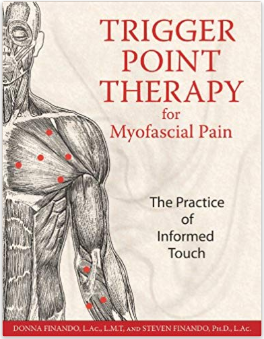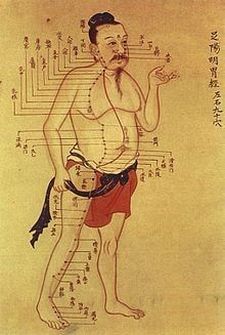|
Many people with muscular or skeletal problems will visit a physiotherapist or chiropractor who may insert acupuncture needles into various places on the body. Unless the therapist has training in Traditional Chinese Medicine, they are usually inserting the needles into trigger points as opposed to acupuncture points. Dry Needling:
A trigger point is a muscle knot. Muscles are made up of bands of fibres wrapped into bundles. If the fibres contract and knot, they are known as hyper-irritable spots. Because the muscle has become tightened, it is unable to lengthen and contract like healthy muscle tissue. This in turn, can pull on tendons and ligaments associated with the muscle and can cause pain in the related joint. Stretching a muscle with a heavily contracted trigger point can further damage the ligament or tendon by tearing it. When muscle fibres contract, they use biochemical energy, and depletion of these biochemicals can lead to the accumulation of toxins, such as lactic acid. The tightened muscle fibres constrict capillaries and prevent them from carrying off the fatigue toxins to the liver and kidneys for recycling. Clusters of trigger points are not uncommon in larger muscles. A key trigger point is one which refers pain along a nerve pathway and treatment of this trigger point can resolve satellite points. There are more than 600 potential trigger points which tend to occur in the same place in human muscles, so trigger point maps have been created, providing accurate advice on treatment. Trigger points in the sternocleidomastoid muscle, for example, can lead to dizziness and nausea as well as symptoms which appear primarily in the head and face. Migraine, sinus headache and inner-ear problems can be due to trigger points in this muscle. In the muscles, there are special receptors called nociceptors. The nociceptor associated with trigger point pain becomes activated when the needle is inserted. It is believed that the pain experienced with this procedure increases a person’s pain threshold, leading to a decrease in pain. The muscle, too, will decrease in tone as a result. In my experience, dry needling can be very painful! Acupuncture on the other hand, is not painful at all, just sometimes, slightly uncomfortable. Many people with muscular or skeletal problems will visit a physiotherapist or chiropractor who may insert acupuncture needles into various places on the body. Unless the therapist has training in Traditional Chinese Medicine, they are usually inserting the needles into trigger points as opposed to acupuncture points. Acupuncture: Acupuncture traces its history back at least 8000 years. Acupuncture points are chosen along energetic pathways called meridians. Each meridian has a specific path and is named according to an abdominal organ. Although the meridians are seen as separate, they do in fact run in a set sequence, so a point worked on one meridian can have an effect on another meridian and its associated internal organ. Every meridian has a superficial and a deep branch. Acupuncturists (and shiatsu therapists) access the superficial flow indicated by the solid line. Each meridian has a number of points along its length which have specific actions and functions. For example, on the palm is a point which calms the mind and aids in falling asleep. Because each meridian is connected to a specific organ, working points on the meridian can assist with imbalances of the associated organ. For example, a tight chest, asthma or inability to “let go” emotionally can be treated by working Lung 7 on the wrist. Points are named according to the location and organ name. Lung 7 is the 7th point along the Lung meridian. The subject of Traditional Chinese medicine is vast and intricate, and many years of study are required in order to become proficient in this modality. Understanding the complex relationship of the organs with emotions, flavours, seasons, time of day, voice sounds, and sense organs is an exciting adventure. Comments are closed.
|
AuthorI've been fascinated in Traditional Chinese Medicine since the late '90s when my reflexology course introduced me to the meridians. Since then I've thoroughly enjoyed learning more about most things holistic. Archives
May 2021
Categories |


 RSS Feed
RSS Feed